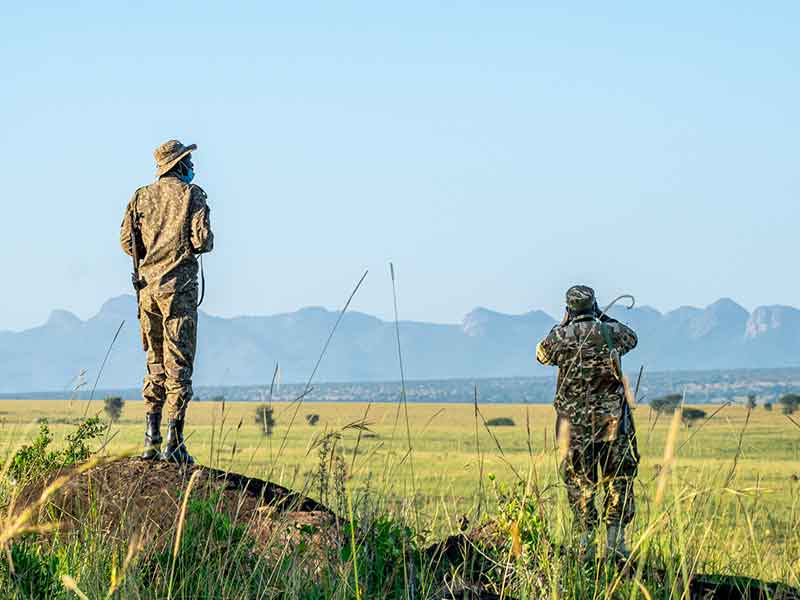Kidepo Valley National Park (KNP) is located in Kaabong district, Karamoja sub-region, in the north-eastern corner bordering South Sudan to the east and Kenya to the west. Karamoja is a semiarid and low-lying plain that stretches from the shores of Lake Opeta (1,050 m), a Ramsar site in eastern Uganda, home to Uganda’s only endemic bird, the Fox’s weaver, and gradually rises, north-east toward the escarpment of the Great East African Rift Valley along the border with Turkana County, Kenya.
The plain is characterized by several volcanic physical features, from rock kopjes to dry mountains, including Mount Morungole 2,750 m in Kidepo Valley National Park. Among other volcanoes in Karamoja are Mount Moroto (3,083 m), Mount Kadam (3,063 m), and Mount Napak (2,500 m), which offer incredible hiking and eco-camping opportunities. As such, the geographical features, wildlife, and the Karimojong people’s way of life are relatively unique from those in west and central Uganda. Karamoja is a must-visit gem in Uganda for a keen photographer.
Flora and fauna
Kidepo covers 1,442 sq. km of extensive open savanna plains interspaced with various acacia tree species such as Acacia nilotica (commonly known as the gum arabic tree) and Commiphora africana, known for its resin. Narus and Kidepo Valleys are two prominent features within Kidepo National Park, each offering unique scenery and vegetation. Along the rivers there are figs (Ficus spp.) and borassus palms. The mosaic papyrus swamps contain water lilies, known for their large, round leaves and vibrant flowers that float on the water’s surface and provide important habitat and food sources for birds and aquatic species.
Narus River Valley offers a permanent source of water and sustains a variety of herbivores such as African elephants, buffaloes, Nubian giraffes, Burchell’s zebra, hippos, and antelope species like Jackson’s hartebeest, Uganda kobs, impala, elands, topi, bushbucks, and oribi, making it a prime area for wildlife viewing. Kidepo River Valley, on the other hand, is seasonal and contains thicker woodland vegetation along the rivers. It is home to species adapted to more wooded environments, including leopards, bushbucks, and buffalo.
Kidepo Valley National Park is renowned for its high diversity of wildlife: 86 mammal species, including predators like lions, leopards, cheetahs, bat-eared foxes, stripped hyenas, and black-backed jackals. Kidepo is the next best place to see zebras, Nubian giraffes, impalas, elands, and topi, apart from Lake Mburo national park.
Birds
Kidepo also boasts a rich avifauna with over 475 species of birds, making for a good destination for birdwatchers on Uganda safari seeking to spot a wide range of species in one location. There are species adapted to the semi-arid environment that are rare to find in other parts of Uganda, including the Karamoja apalis, a small, inconspicuous bird; the Abyssinian ground hornbill; the ostrich, the world’s largest bird; rose-ringed parakeets; and red-throated bee-eaters. Kidepo also boasts over 56 raptor species that include secretary bird, lapped-faced vulture, African crowned and long crested eagle, and the Peregrine Falcon (Falco peregrinus), known for its incredible speed and aerial hunting prowess, particularly of other birds.
Local people
Kidepo Valley National Park is surrounded by the Karamojong people, a semi-nomadic pastoralist ethnic cluster of tribes, including the minority IK. Karimojong, the largest group within the cluster, is known for their traditional cattle herding practices, such as drinking fresh milk and blood of fatty bulls. When they slaughter cows and lambs for meat, they also use bi-products such as dung, hides, and skins for home decorations. Among other unique customs include high jump dance and body scarification, almost similar to those of the famous Maasai of Kenya and Tanzania. Cattle symbolize wealth and status within the community, and the traditional housing of the Karimojong people, known as manyatta, reflects their nomadic and pastoralist lifestyle.
Their homesteads can be visited in Lorukul, Kaperimoru, Kawalakol, and Kalenga on the way to or from the park via the Eastern Uganda route. Visiting the Karamoja homesteads offers an opportunity to interact with the craftsperson. You can learn how a wide range of arts and crafts are made, including the making of colorful beads and jewelry, which is an integral part of clothing and beauty, especially among women. Those in Entebbe town can obtain Karamoja souvenirs at the Bafrika Creationz Art Gallery next to Entebbe Botanical Gardens. In addition to cattle, some of the Karamojong people practice subsistence farming, including the growing of sorghum, millet, and maize. Some also engage in hunting and gathering, such as the IK tribe, who live on the slopes of Mount Murongole.
Activities in Kidepo Valley National Park
Game drives
Game drives in Kidepo National Park are mainly done in the Narus Valley, given that most of the park’s mammal species tend to dwell there all year round due to permanent water sources, open plains, and rock jopjes. Game tracks including Nagusokopire, Kakine, and Katurum start at the Apoka UWA visitor center and wind through the various sections of the Narus valley. Those intending to explore and discover more of the park can opt for the new tracks that UWA has opened up north-west of Apoka and to the south of the crocodile pool. The rest camps at Apoka and Kakine offer observation points where visitors can get spectacular views of Narus Valley and the soaring mountain ranges.
Kidepo valley
A game drive in the Kidepo Valley is a better option for a keen photographer who isn’t much interested in wildlife. The Narus-Kidepo watershed is one of the spectacular scenery. There are opportunities to walk across the riverbeds made of dry sand to the Kanangorok Hot Springs. In addition to scenery, Kidepo Valley also offers some sightings of leopards, ostriches, and buffaloes.
Some of the lodges and tour operators collaborate with local communities around Kidepo Valley National Park to offer guided cultural tours and homestays, which offer opportunities to get some of the locally made Karamoja arts and crafts and authenticity of their culture.
Ik tribe community tour
The IK cultural tour involves visiting the IK community on the slopes of Mount Murongole. The IK were once hunter-gatherers, but over time, their mode of survival evolved to include subsistence farming and beekeeping. According to the Cross-Cultural Foundation of Uganda, the total population of the Ik is 14,000, of which 6,500 are males and 7,500 are females. The IK, however, continue to maintain their traditional customs and speak their native tongue.
Best time to visit Kidepo Valley National Park
Visiting Kidepo National Park means considering the best times for different activities like game drives, bird watching, and photography, which are influenced by seasonal changes and wildlife behavior. The dry season from March, June, to September is the best time for game drives in Kidepo National Park. Due to clearer visibility and reduced vegetation, spotting wildlife can be easier. During the morning, animals are active, and in the afternoon, they tend to gather around permanent water sources within the Narus River valleys, which increases the likelihood of encounters with lions, elephants, giraffes, zebras, and other iconic African species. In addition to good weather, the road conditions are generally better, facilitating smoother game drives.
Bird watching in Kidepo can be rewarding throughout the year, however. The dry season overlaps with the breeding season for many bird species in Kidepo Valley National Park. Birds are more active, vocal, and colorful during this time as they establish territories and court mates. Those intending to spot migratory species can visit in November to April.
How to get to Kidepo Valley National Park
Kidepo Valley National Park is 571 km (10-hour drive) north east of Kampala capital city via the Kampala-Karuma-Gulu-Kitgum-Kidepo route. This route offers an option to go through Murchison Falls National Park. Getting to Kidepo via the eastern Uganda circuit, there are 2 routes to consider, which include the Kampala-Mbale-Nakapiripiti-Moroto-Kotido-Kaabong-Kidepo route (740 km/12-hour drive) and the 792 km (13-hour drive) Kampala-Mbale-Soroti-Moroto-Kotido-Kaabong-Kidepo route. The Eastern Uganda safari circuit offers a wide range of adventure, wildlife, and cultural attractions to visit along the way to Kidepo, including the Source of the Nile Jinja, Nyero rock paintings in Kumi, the Lake Opeta Ramsar site, Mount Elgon, Sipi Falls, and Kapchorwa. Community Tourism Initiatives: some lodges and tour operators collaborate with local communities to offer guided cultural tours, home stays, and opportunities to purchase locally made crafts.

